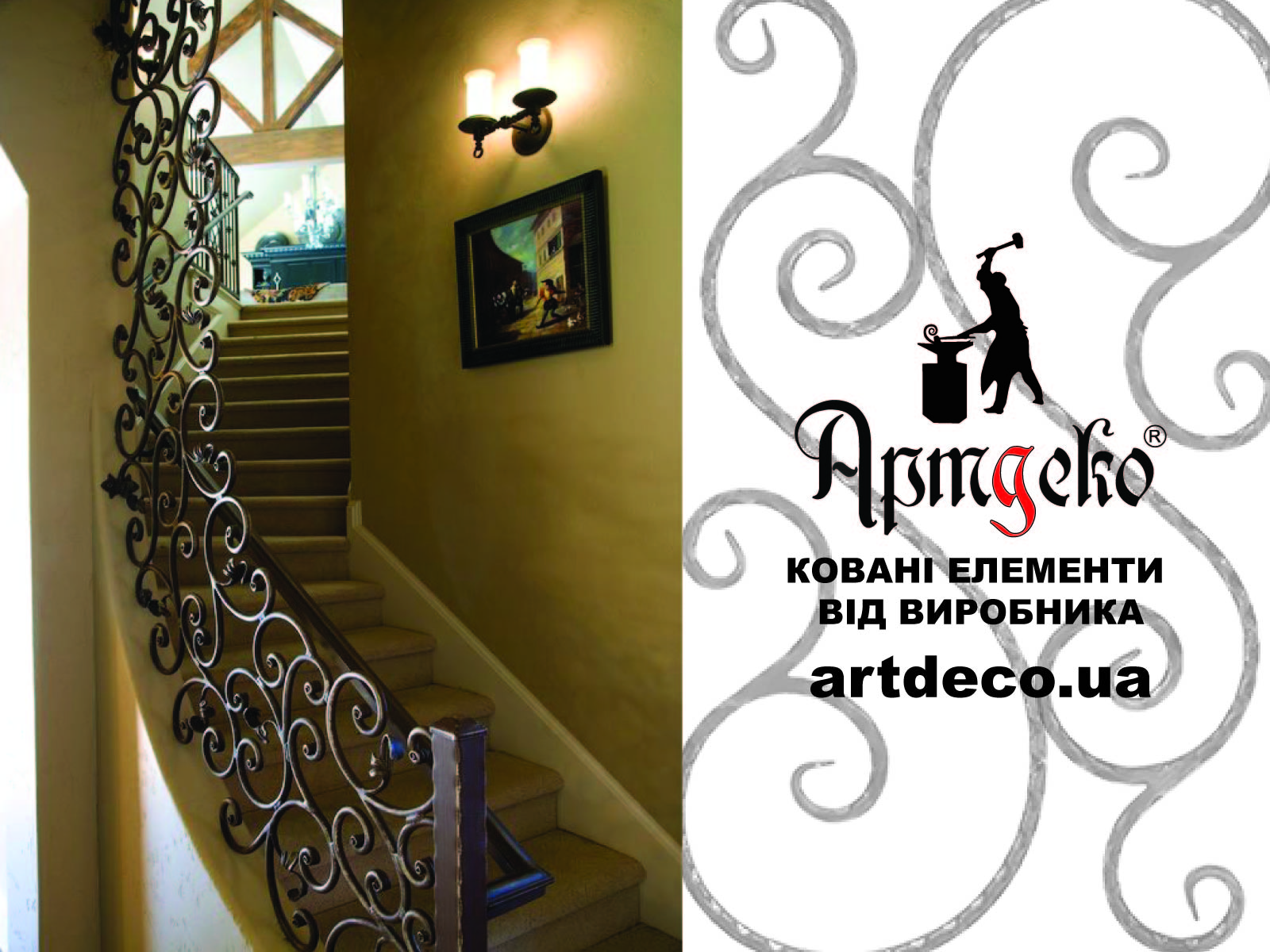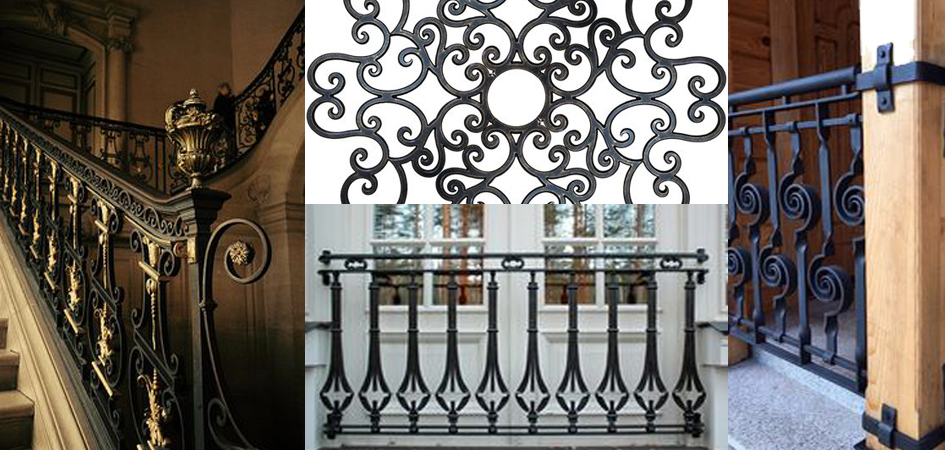Thinking about decorating a house or suburban area with forging, many customers ask for a hint in what style is best to decorate. There are no special requirements in choosing a forging design when decorating arbors, fences or gates. It all depends on the general style of the residence and the taste of the owner, so if you want to decorate with a wrought-iron interior or exterior, it will be useful to have an idea of the different artistic styles.
VANGUARD FORGING
The avant-garde breaks all stereotypes, offering a different approach to the formation of space and experiments with it. Therefore, there are many non-standard shapes and opposites - the opposition of strict geometry to broken lines and curls is welcome.
Specific traits:
• non-standard;
• severity;
• functionality;
• contrast of shapes, lines and sizes.
FORGING IN ENGLISH
The English style of forging was influenced by the "foggy Albion" with its pomp, grandeur and severity of lines. At the same time, English forging cannot be denied elegance and entertainment. Peaks, coats of arms, lions, interweaving of ovals and royal symbols - all this is reflected in the elements of forged items.
Main design features:
• combination of rigor and elegance;
• simplicity and elegance in each element;
• goes well with wood.
EMPIRE FORGING
Empire style is a French style characterized by solemnity and pomp. It has absorbed all the architectural traditions of more ancient civilizations, therefore it gravitates towards grandeur and massiveness. A striking example of the Empire style in architecture is the Arc de Triomphe. They are characterized by clarity, strict geometry, repeating elements of military themes or statehood.
Empire Traits:
• severity and elegance nearby;
• natural motives;
• smooth rods;
• correct geometry.
FORGING IN ART DECO STYLE
The Art Deco style is expressed in curls. Often they are connected to each other in an original way, not smoothly, but with broken lines. Most often, Art Deco in forging is combined with "aged" metal and different materials: glass, marble, wood.
Specifications:
• vertical lines with rounded edges;
• decorativeness;
• geometric shapes - zigzags, triangles, rectangles, ovals.
BAROQUE FORGING 
Baroque forging allows you to demonstrate excessively lush and majestic forms with an excessive amount of decorative elements.
Main features:
• luxury and splendor;
• an abundance of patterns;
• elements - curl, spirals, volutes, leaves, flower garlands.
ORIENTAL FORGING
Forging in the oriental style is quite variable, because the elements can be either in the form of strict lines, or in the form of light, smooth, rounded elements, often using flowers, leaves, patterns of oriental ornament.
Characterized by:
• focus on ornament;
• streamlined shapes.
GOTHIC FORGING STYLE
Gothic is characterized by multi-petal inflorescences, oak leaves, lancet elements. Natural ornaments are intertwined in an original way with geometric shapes.
The main features of the Gothic style:
• majesty and aspiration upward;
• geometry of patterns, a lot of air and space;
• many vertical elements.
EUROPEAN ART FORGING STYLE
Several design schools belong to the European style: chalet, Provence, country, half-timbered.
All areas of the European style are characterized by rural or folk motives and simplicity. Combination with other materials is allowed: metal and wood.
INDIAN FORGING STYLE
The Indian style is a bit like the oriental one and also includes a lot of air and patterns.
Its characteristics:
• vegetable patterns;
• small forged elements woven into stylish patterns.
FORGED CHINESE STYLE
The Chinese style is characterized by roundness and lack of sharpness. It is characterized by smooth lines and smooth patterns without sharp protrusions, tops. All geometry is soft and calm, the lines are wavy.
• softness of lines;
• absence of sharp corners;
• harmony.
CLASSIC STYLE 
Classics are always austerity, laconicism, alternating rhythm and graphic contour. Recognizable elements are spears, meanders, rectangles, reliefs and circles with rosettes.
Main characteristics:
• harmony of the whole ensemble, elements balance each other, symmetry is preferred;
• brevity and restraint of forms.
COLONIAL FORGING STYLE
The colonial style is the result of a mixture of two directly opposite cultures: European and indigenous, therefore it is characterized by luxury and original flavor.
Its main features:
• richness of forms and practicality;
• exotic flowers, birds or animals.
LOFT FORGING
The loft includes urban modern motives, artistic roughness and unpretentiousness. Style denies any pathos and glamor in interior items.
Traits:
• it is minimalism, laconicism and simplicity of lines;
• progressiveness;
• artistic simplicity.
FORGING IN THE STYLE OF MINIMALISM
Minimalism requires that there is nothing superfluous in the interior. Therefore, preference is given to straight lines; there are no ornaments, decorative relief elements.
Minimalism Traits:
• brevity;
• minimal decorativeness;
• simplicity of forms.
FORGING MODERN
Modern is characterized by rounded outlines without corners with a tendency to asymmetry. Preference is given to natural plant motifs, a special role is played by the exotic - irises, orchids, cyclamens.
Main characteristics:
• amorphous and asymmetric pattern;
• smoothness and harmony.
NEOCLASSICISM IN KOVKA
Neoclassicism reintroduced curl forged elements into use, making it larger. Common elements include leaves, rosettes, wreaths, and a host of different types of reliefs.
Individual traits:
• aesthetics;
• restraint of lines and shapes;
• some decorative elements.
STYLE POST-MODERNISM
Postmodernism permits “everything” in forging, so elements from completely different styles are combined here.
Its differences:
• smoothness of forms is adjacent to straight lines;
• a lot of contrast and space in elements and shapes.
RENAISSANCE FORGING
Forging in the Renaissance style seems weightless, since it has no frames, and is created from graceful weaves of the most original forms. Any pattern that has many overlapping curls and other elements evolves from the center.
Its main features:
• perfect lines;
• reference to antique motives;
• symmetry and harmony.
FORGING IN THE ROCOCO STYLE
Rococo is characterized by a minimum of rigor and elegance and playfulness of forms. Drawings are broken and crushed, a slight asymmetry of forms appears.
The main features of Rococo:
• airiness and playfulness;
• decorativeness comes to the fore;
• asymmetry of elements.
ROMAN FORGING STYLE
The Romanesque style is a luxury and at the same time simplicity in forging, characteristic of ancient Roman palaces. The traditional pattern is a tree of curls.
Its main features:
• solidity and greatness;
• symmetry of elements;
• semicircular arches.
FORGING IN THE STYLE OF ROMANCE
Refinement and elegance, plastic lines are credited to romanticism. Balance of proportions, complex patterns with perfect symmetry are welcomed in forging.
Main features:
• refinement and elegance;
• grace and airiness;
• ornate forms.
RUSSIAN FORGING STYLE
The main features of the Russian style are the abundance of bulky, convex elements, curls and monograms. Basically, this type of forging is used for landscape design, since the style is heavy for interior forging.
Its features:
• convexity of forms;
• the predominance of vegetation and the symbolism of Russian culture.
RUSSIAN-BYZANTINE STYLE
The Russian-Byzantine design is dominated by clear geometric elements and stylized floral motifs that form a complex ornament. Among the elements are the interweaving of geometric patterns with intricately forged leaves.
Style features:
• complexity and grandeur;
• combination of floral and geometric ornaments;
• the complexity of the pattern and symmetry.
STEAMPUNK FORGING STYLE
Steampunk is characterized by unusual and mysterious figures that take viewers into the world of phantasmagoria.
Its differences:
• rigor and tightness of forms;
• old motives;
• availability of technical details.
FORGING STYLE FUSION
Fusion is a kind of fusion of different styles. It can be whimsical and quirky.
Specifications:
• connects modern and historical designs;
• unusual and whimsical details.
FORGING STYLE HI-TEC
High-tech looks beautiful in combination with glass elements. The main features that distinguish the style from other design directions are the absence of frills, the presence of clear geometric shapes and an abundance of straight lines.
Specifications:
• restraint and simplicity;
• strict forms;
• feeling of high cost of style.
FORGING STYLE ECLECTIC
Eclecticism is a collective style with massive, pretentious elements, richness, emphasized by the representativeness of forms.
Eclectic traits:
• baroque and gothic elements;
• originality and uniqueness.
Catalog
